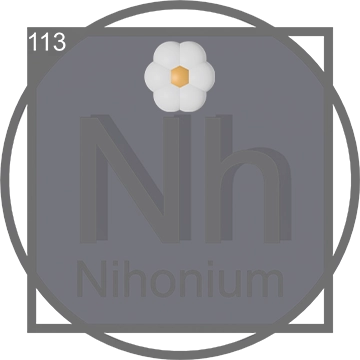Understanding Nihonium (Nh): From Discovery to Technological Applications
Introduction to Nihonium (Nh)
Nihonium (Nh) is a synthetic element with the atomic number 113. As a rare addition to the periodic table, Nihonium stands out due to its unique properties and the intriguing story of its discovery. This superheavy element is part of the p-block and is classified under post-transition metals in the periodic table.
The Discovery of Nihonium (Nh)

Nihonium was officially recognized and named in 2016 by the International Union of Pure and Applied Chemistry (IUPAC). The element was discovered by a team of scientists at the RIKEN Nishina Center for Accelerator-Based Science in Japan. The discovery process involved the fusion of zinc and bismuth atoms in a particle accelerator, which resulted in the synthesis of Nihonium.
Nihonium (Nh) in the Periodic Table
Nihonium is located in Group 13 of the periodic table, sharing its group with elements like boron, aluminium, gallium, indium, and thallium. As part of this group, Nihonium shares certain chemical properties with its group members, albeit with a greater instability due to its radioactive nature.
For more details about its position and neighboring elements, consider exploring our comprehensive periodic table.
Scientific Significance of Pure Nihonium (Nh)

The creation of Pure Nihonium marks a significant achievement in the field of nuclear chemistry and physics. It provides insights into the behavior of superheavy elements and the theoretical "island of stability" in the periodic table. This theoretical model suggests that some superheavy nuclei, like Pure Nihonium, might exhibit much longer half-lives than those around them, leading to potentially more stable new elements. The image above shows a sample of Pure Nihonium, highlighting its distinctive metallic luster.
Applications of Nihonium (Nh) in Technology
While Nihonium does not currently have practical applications due to its extremely short half-life and the tiny amounts in which it is produced, its study is crucial for advancing nuclear science. The research into superheavy elements like Nihonium could lead to discoveries of more stable elements with practical applications in technology and industry.
How Nihonium (Nh) is Made
Nihonium is a synthetic element produced in particle accelerators through nuclear fusion. This process involves bombarding bismuth with zinc ions, where the nuclei fuse to form Nihonium. The equation representing this synthesis is typically represented as: Bi^{209} + Zn^{70} \rightarrow Nh^{278} + n.
Mining and Associated Resources
As a synthetic element, Nihonium is not mined. However, the production of Nihonium involves materials that are mined:
- Bismuth: Found in ores with lead, tin, and silver.
- Zinc: Often associated with lead and other metals.
Current Uses of Nihonium (Nh)
Currently, there are no practical applications for Nihonium due to its short half-life and rarity. It is primarily used in scientific research to enhance our understanding of the periodic table and nuclear physics.
Future Prospects of Nihonium (Nh)

The research into Nihonium could potentially lead to breakthroughs in various fields:
- Material Science: The synthesis of new materials with unique properties.
- Nuclear Physics: Improved nuclear models and energy sources.
- Chemical Engineering: More effective catalysts for chemical reactions.
The ongoing study of superheavy elements like Nihonium is pivotal for future technological and scientific advancements.












